Do hardened shoreline habitats help or hurt? Quantifying the extent of coregonine spawning and egg incubation suitability on human-modified habitats in Lake Ontario
Contributing Authors
Brian Weidel (USGS); Alex Gatch (USGS); Dimitry Gorksy (FWS); Brian O'Malley (USGS); Josephine Johnson (FWS), Gregg Mackey (USGS); Marc Chalpunicki (USGS); Nick Sard (SUNY-Oswego), Stacy Furgal (Cornell)
Project Description
Conserving and restoring Cisco (Coregonus artedi) and Lake Whitefish (C. clupeaformis) populations is a management objective within individual Great Lakes and at the basin scale. Similar to other fishes of conservation concern, anthropogenic changes to spawning habitat (e.g., sedimentation) and environmental incubation conditions (e.g., reduced ice cover) have been shown to limit coregonine reproductive success. In Lake Ontario, shallow (2 -5 m), hard substrates with interstices attract the greatest Cisco and Lake Whitefish embryo (fertilized egg) deposition and those habitats also have the maximum larval emergence relative to deeper, silt substrates. Unfortunately, interstitial habitats are rare, and generally shallow in Lake Ontario, because most rock substrates have been infilled by sedimentation and dreissenid mussel shells and water levels are lowered ~1.2 m every fall. An experiment that added clean spawning substrate found coregonine embryo survival substantially increased in the clean substrate relative to adjacent control substrates (Fig. 1), further supporting habitat’s role in coregonine embryo survival.
Interestingly, across the Great Lakes, rock substrate, similar to what is added to enhance fish spawning habitat, is added along shorelines or as breakwalls to reduce erosion and attenuate waves. These rock substrates with interstitial spaces have been shown to attract lithophilic lake-spawning salmonids (e.g., Lake Trout), and could also attract coregonine spawning. If coregonines spawn on these structures, it is not known whether embryos can incubate in these habitats, that are most often located in turbulent zones. If the habitats attract deposition but do not incubate embryos, the habitats could function similarly to what Marsden and Chotkowski referred to in Lake Trout spawning as a ‘fatal attraction’. Perhaps most important, is how ubiquitous these habitat modifications are around boat ramps and marinas which are located in tributaries and embayments (Fig. 2.). In Lake Ontario, as other lakes, those same embayments and tributaries historically supported spawning coregonine populations, yet many of those populations have been locally extirpated or are below sampling detection limits.
We propose embryo translocation is an efficient and underutilized method to identify the environmental drivers of coregonine reproductive success. This approach does not restrict research to only those sites where wild fish naturally deposit embryos. Translocation sites can be chosen to span wider gradients of environmental conditions and novel habitats. Embryo translocation, as a method, is not well represented in the primary literature but at least two studies in the Great Lakes used translocated embryos to successfully quantify the effects of physical disturbance and predation on Lake Trout embryo survival. The technique also has potential as a restoration action. In Scotland, C. lavaretus and C. albula embryo translocations developed refuge populations that maintained phenotypic and genotypic diversity of the source population without requiring captive rearing or risking possible deleterious effects induced by captive rearing. Our research team is among the most experienced at quantifying coregonine reproductive ecology across differing habitats and have benefited from recent pilot embryo translocations. For example, in winter 2023 and spring 2024, we translocated and seeded ~25K wild Cisco embryos and 1.3 million hatchery-origin Bloater (C. hoyi) embryos to experimental Lake Ontario sites to better understand the effect of incubation substrate type on coregonine embryonic survival. We have translocated embryos in varying depths from 2 - 35m and developed innovative methods to fertilize and release embryos as naturally as possible to simulate coregonine spawning processes and environmental effects on embryos.
This project will use observational and experimental methods to quantify whether human-modified habitats (e.g., break walls, rip rap) serve, or can serve, as spawning habitat for Lake Ontario Cisco and Lake Whitefish. If modified rock habitats support coregonine embryo incubation there is potential to use translocation and these existing habitats to establish new spawning aggregations. Alternatively, if these ever more common habitats are found to attract deposition but be poor incubation habitat, that may help to explain why some local spawning populations have disappeared or why local populations cannot reestablish from extant refuge populations.
